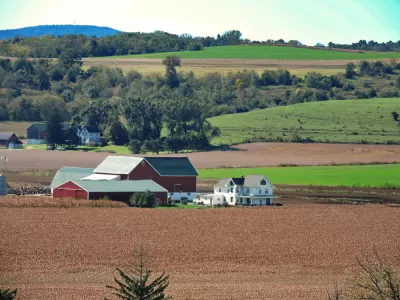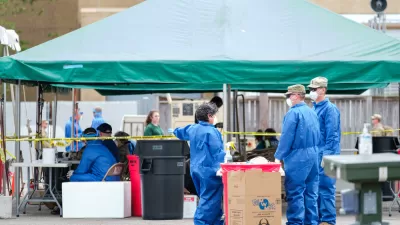Many counties throughout the nation have recorded no deaths from COVID-19. A perception exists that population density is responsible for the massive death toll in New York and New Jersey and that exurban and rural counties may be spared.

Though relatively few counties in the nation appear to have been spared from infection by the coronavirus, a quick look at the counties in the eight states where no "stay-at-home" orders have been issued by their governors shows that many, if not most counties, have recorded very few, if any, deaths, a far cry from the pandemic's epicenter in New York City and New Jersey, the densest city and densest state, respectively, in the nation.
New York State, with over 8,600 deaths from COVID-19 as of April 11, and New Jersey, with almost 2,200, account for almost 53% of all deaths in the U.S., now over 20,500, the highest in the world. With New York Gov. Andrew Cuomo blaming the Big Apple's density for the high infection rate along with many public health experts, it's easy to think that sparsely populated counties, where social distance comes naturally as opposed to by government fiat, will escape the harrowing scenes of hospitals being overwhelmed with COVID patients and refrigerated truck trailers used as mobile morgues.
“South Dakota is not New York City,” said Gov. Kristi Noem of South Dakota, one of the eight Republican hold-out governors, at a news conference on April 1. "Noem has suggested that the stricter measures violated personal liberties, and she said her state’s rural character made it better positioned to handle the outbreak," report Jack Healy, Sabrina Tavernise, Robert Gebeloff and Weiyi Cai of The New York Times on April 8.
But many rural doctors, leaders and health experts worry that is exactly where their communities are heading, and that they will have fewer hospital beds, ventilators and nurses to handle the onslaught.
Doctors and elected officials are warning that a late-arriving wave of illness could overwhelm rural communities that are older, poorer and sicker than much of the country, and already dangerously short on medical help.
No escaping the virus
"The virus not only doesn't respect national or state borders, but it also doesn't limit itself to just cities," Ashish Jha, director of the Harvard Global Health Institute, told CNN Newsroom host Poppy Harlow on April 8.
"Obviously suburbs and rural areas are less dense, and that doesn't mean that the virus isn't coming, it just means it's going to come a little later, and that it's going to spread a bit more slowly."
Oklahoma
The Post reporters explore several high profile cases in small towns like Magnum, Oklahoma in Greer County [pop. 6,000], which has an infection rate of 623 per 100,000 people, according to FOX 25 News, higher than New Jersey. Like some other rural outbreaks, it appears to be linked to church attendance, resulting in four deaths. The mayors of Magnum and nearby Altus have issued stay-at-home orders, curfews, and mandatory mask-wearing when within six feet of other people.
Oklahoma Gov. Kevin Stitt, another of the Republican hold-out governors, who was criticized last month for essentially mocking the need for social distancing, has not gone so far as to prevent local governments from issuing stay-at-home orders like another hold-out, Gov. Asa Hutchinson of Arkansas, who maintains such orders must be issued on a statewide basis only.
Stitt issued a “Safer at Home” order on March 24 which calls "for adults over the age of 65 and vulnerable individuals with serious underlying medical conditions to remain at home. Gov. Noem of South Dakota issued a similar order on April 6 although it applies only applies to Minnehaha and Lincoln counties, the first and third most populous in the state.
“We feel like [Gov. Stitt's order] really should apply to all ages, not just to the elderly or immunosuppressed,” said George Monks, the president-elect of the Oklahoma State Medical Association, reports Samantha Vicent for Tulsa World. "The association was among many advocacy groups in the state that signed a letter to Stitt on March 23 asking for a shelter-in-place order."
Hospital resources
On April 10, Stitt announced a hospital surge plan to prepare for residents suffering from COVID-19. “Our comprehensive plan ensures Oklahoma will be in good shape on total hospital beds, ICU beds and ventilators, even if we are faced with the worst-case scenario," he stated.
According to a deep dive by The Washington Post on the strain that the coronavirus will place on the health resources, "125 million adults, or 48 percent of the U.S. adult population, live where virus patients could overwhelm the supply of mechanical ventilators. Those breathing machines are among the key hospital resources that can help patients facing death when the disease attacks their lungs."
The Post conducted a stress test of sorts on available resources, which revealed a patchwork of possible preparedness shortcomings in cities and towns where the full force of the virus has yet to hit and where people may not be following isolation and social distancing orders.
Another critical issue to consider for the ability of rural areas to deal with the virus is that "[r]ural populations tend to be older and face a higher risk of death from heart disease, cancer, lower respiratory disease, stroke, and unintentional injuries," according to Healthline Media.
The final word goes to Jha of the Harvard Global Health Institute. "I'm really worried because hospitals in the suburbs and rural areas don't have as many ICU beds, don't have the same capacity [as their more urban counterparts]. So, unfortunately, this is something we're all going to be dealing with no matter where we live in America."
Additional pandemic reading:
- New York Times coronavirus tracker: Cases and deaths by state and county, including per capita.
-
Streetsblog NYC: Op-Ed: Dear Gov. Cuomo, The Problem Is Crowding, Not ‘Density’! by Apr 6, 2020
-
Tree Hugger: City, suburb or country? Where's the best place to ride out this crisis? by Lloyd Alter, March 19, 2020
- CityLab: Are Suburbs Safer From Coronavirus? Probably Not, by Laura Bliss and Kriston Capps, March 13, 2020
Related in Planetizen:
- Predicting Hospital Capacity as the Coronavirus Spreads, March 27, 2020
Hat tip to Rachel Maddow.
FULL STORY: Coronavirus Was Slow to Spread to Rural America. Not Anymore

Planetizen Federal Action Tracker
A weekly monitor of how Trump’s orders and actions are impacting planners and planning in America.

Chicago’s Ghost Rails
Just beneath the surface of the modern city lie the remnants of its expansive early 20th-century streetcar system.

San Antonio and Austin are Fusing Into one Massive Megaregion
The region spanning the two central Texas cities is growing fast, posing challenges for local infrastructure and water supplies.

Since Zion's Shuttles Went Electric “The Smog is Gone”
Visitors to Zion National Park can enjoy the canyon via the nation’s first fully electric park shuttle system.

Trump Distributing DOT Safety Funds at 1/10 Rate of Biden
Funds for Safe Streets and other transportation safety and equity programs are being held up by administrative reviews and conflicts with the Trump administration’s priorities.

German Cities Subsidize Taxis for Women Amid Wave of Violence
Free or low-cost taxi rides can help women navigate cities more safely, but critics say the programs don't address the root causes of violence against women.
Urban Design for Planners 1: Software Tools
This six-course series explores essential urban design concepts using open source software and equips planners with the tools they need to participate fully in the urban design process.
Planning for Universal Design
Learn the tools for implementing Universal Design in planning regulations.
planning NEXT
Appalachian Highlands Housing Partners
Mpact (founded as Rail~Volution)
City of Camden Redevelopment Agency
City of Astoria
City of Portland
City of Laramie





























